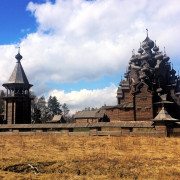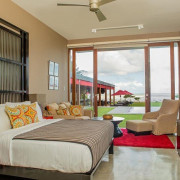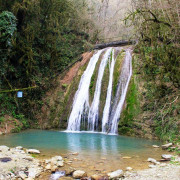Достопримечательности бразилии: топ-30
Содержание:
- Brazilian geography
- Климат
- Interesting facts Brazil symbols
- Brazil number ones
- Краткая история
- Higher education
- Brazil is massive
- Funny Brazil facts
- Facts about slavery in Brazil
- Общая информация о Бразилии
- Credits
- Растительный и животный мир
- Brazilian achievements
- Brazilian statistics
- Social data
- Полезная информация для туристов
Brazilian geography
Brazil is mostly a tropical country that has many geographical features in its territory, from desert to rainforest and mountain.
The highest mountain in Brazil is Neblina Peak, reaching 9,822 ft (2.994 m). This massive Brazil fact (pun intended) is a blast for adventure and hike lovers.
That’s because Neblina Peak is a unique and challenging hike that takes you to the limit before even you get to the mountain.
The whole trip includes a boat, 4×4 jeep, and trekking through the jungle to reach Brazil’s highest point. Totally worth it.
And while Brazil has many modern cities, colonial towns, pristine beaches, and breathtaking mountains, the second-most visited place in the country is the Iguazu Falls.
The entrance gate for most visitors is Rio de Janeiro, of course.
As for its borders, Brazil borders all countries in South America, except Chile and Ecuador.
Климат
Несмотря на то, что 90% территории страны находятся в тропическом поясе, более 60% населения Бразилии проживает в зоне умеренных температур, формирующихся под воздействием преобладющих высот, дующих со стороны моря ветров и фронтов холодного воздуха.
В Бразилии представлены пять климатических типов: экваториальный, тропический, полузасушливый, тропический высокогорный, и субтропический. Для городов, расположенных на равнинной местности, таких как Сан-Пауло, Бразилиа и Бело-Оризонте, характерны умеренные температуры среднее значение которых составляет + 19 градусов.
#BANNER#
Города Рио-де-Жанейро, Ресифи и Салвадор, расположенные на побережье, характеризуются жарким климатом, который смягчает тропический ветер.
Субтропический климат южных городов, таких как Порто-Алегре и Куритиба, сравним с некоторыми регионами США и Европы, где случаются периодические заморозки. Зимой в этом поясе температура может опускаться ниже нуля.
Несмотря на расхожее мнение о том, что в бассейне Амазонки царит невыносимая жара, температура в этом районе не превышает + 32 градусов, а ее среднегодовое значение составляет + 22-26 градусов при незначительных сезонных колебаниях в самые жаркие и самые холодные месяцы года.
Самый жаркий район Бразилии — это северо-восток. В период засухи, длящийся с мая по ноябрь, температура воздуха на северо-востоке повышается до + 38 градусов. По сравнению с Амазонкой этот район Бразилии характеризуется более резкими сезонными колебаниями температур. Вдоль побережья Атлантического океана от Ресифи до Рио-де-Жанейро средняя температура колеблется от + 23 до + 27 градусов.
На возвышенных территориях в глубине страны температура понижается до + 18-23 градусов. К югу от Рио-де-Жанейро различия между временами года становятся более отчетливыми, а сезонные колебания температур — более ярко выраженными. В этом районе страны среднегодовое значение температур составляет от + 17 до + 19 градусов.
Времена года в Бразилии распределяются следующим образом:
Весна: с 22 сентября по 21 декабря
Лето: с 22 декабря по 21 марта
Осень: с 22 марта по 21 июня
Зима: с 22 июня по 21 сентября
Interesting facts Brazil symbols
São Paulo State’s flag was supposed to be Brazil’s flag
After the country became a republic, people wanted a new flag to represent a new beginning.
Many projects were presented to the authorities at the time. Still, the current flag of São Paulo is one of the best-known rejected projects.
And because of this rejection, the state of São Paulo won a tricolor flag where each color represents the major ethnic groups in Brazil.
The black represents the African slaves who built the country, the white represents the European immigrants, and the red represents the Indigenous people of our lands.
The stars on the Brazilian flag depicts a specific starry night
The starry night on the flag, a national symbol of Brazil, isn’t any ordinary night, but the one of November 15, 1889, as seen from Rio de Janeiro.
On that day, a military coup d’etat established the Republic of Brazil, and an astronomer was asked to draw the sky above their heads and mark that day in history. (And in our flag too.)
The lone star in the flag isn’t the capital, Brasília
Each star on the Brazilian flag represents a state or the capital.
While many people believe the lone star at the top half of the flag is Brasília, the country’s capital, I can tell you that’s a big misconception.
In fact, that star represents Pará, a northern state. At that time, Pará was the northernmost state in Brazil, Amapá and Roraima were created later.
And since each state’s position was chosen according to their location in Brazil, Pará is the lone star.
Brazil number ones
São Paulo is the largest city in the southern hemisphere
Brazil’s vibrant financial center, São Paulo metropolitan area, has about 21 million residents, while the city has approximately 12 million.
No wonder people call it the New York of South America. São Paulo is a massive city.
Brazil has more animal and plant species than any other country in the world
There’s a consensus in the biology world that Brazil is the most biodiverse country on the planet and rightly so because Brazil has the most known plants, amphibians, freshwater fish, and mammals.
Brazil has two biodiversity hotspots (the Atlantic Forest and savanna, known as cerrado), six terrestrial biomes, and three large marine ecosystems.
At least 103,870 animal species and 43,020 plant species are currently known in the country, comprising 70% of the world’s cataloged animal and plant species, according to Biofin.
Brazil has been the largest producer of coffee for the last 150 years
If you’re a coffee drinker, odds are you drank Brazilian coffee this year.
That’s because Brazil is by far the world’s largest producer and exporter of coffee, accounting for 30% of the world’s production.
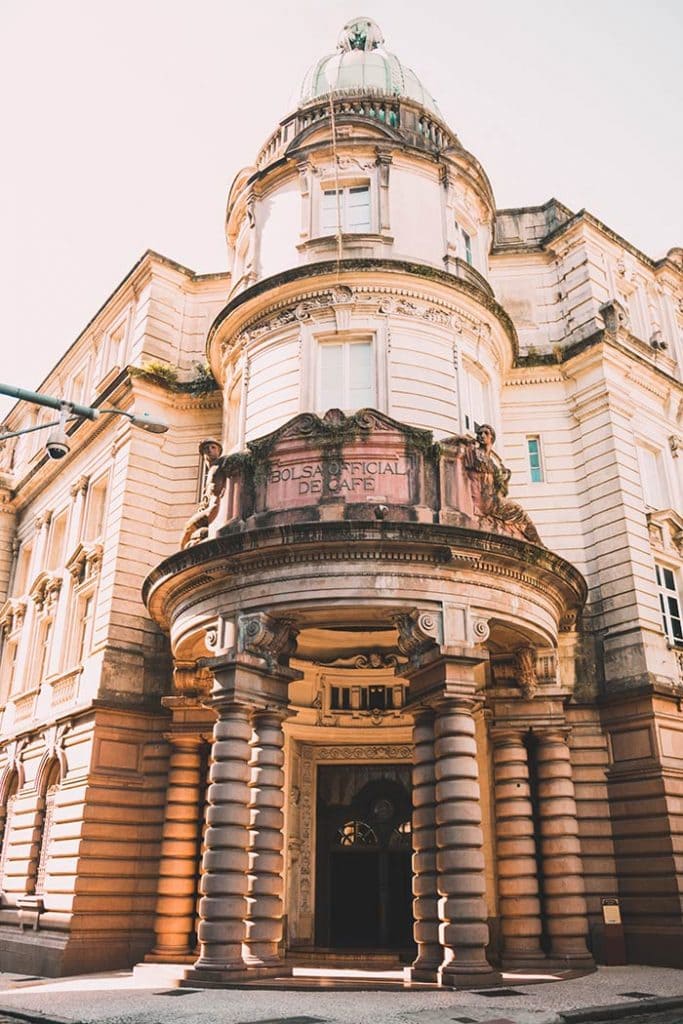
Brazil facts: The country has been the largest producer of coffee for the last 150 years
Краткая история
Федеративная Республика Бразилия, история которой началась в начале XVI столетии, – это страна, которая многое испытала на своем веку. В 1500 году мореплаватель Кабрал из Португалии открывает европейцам новые земли, на которых обитали индейские племена, а через 30 лет начинается колонизация страны. Сюда прибывают первые переселенцы и основывают ряд феодальных владений (капитании). Вскоре на тростниковых плантациях колонистов появляются рабы из Африки.
В XIX веке принц Жуан из Португалии, спасавшийся от войск Наполеона, провозглашает государство королевством. Через несколько лет его сын, объявивший Бразилию независимой, получает титул императора и отменяет рабство в стране. После свержения его власти, с 1889 года и по настоящее время Бразилия является федеративной республикой. Бывшие провинции, называемые штатами, получили автономию и собственные законодательные органы.
До середины 80-х годов прошлого века года страна находилась под властью авторитарных президентов, и только 30 лет назад начался период демократизации. Принципы государственного устройства действуют и поныне, а в конституцию вносятся новые поправки.
Higher education
There are several institutions of higher learning in Brasília, including: Universidade Católica de Brasília, Centro Universitário de Brasília, Centro Universitário do Distrito Federal, Centro Universitário, Instituto de Educação Superior de Brasília, União Pioneira da Integração Social, Universidade Paulista, and the Universidade de Brasília (University of Brasília.)
The University of Brasília (UnB), which opened in 1962, is central to much of the city’s cultural life. The architect Oscar Niemeyer designed its main building, the Central Institute of Science (ICC). UnB, located in the heart of Brasília on the banks of Paranoá Lake, is one of the most respected institutions in Brazil. Its modernistic buildings house 23 institutes and schools; 50 departments; 16 scientific, technological, cultural, artistic, and general service centers; student, faculty and staff residences; a hospital; a sports center equipped with swimming pools, racetrack, and various sports fields and courts; a seismological observatory capable of registering earthquakes across the planet; an animal-research laboratory and an ecological station. UnB is also about to build its own technological park. UnB’s central library has the largest archive in midwestern Brazil and caters to the needs of the Federal District and of researchers from across the nation. UnB also maintains the Fazenda Água Limpa, a farm in the outskirts of Brasília where ecological, agricultural, and forestry research is conducted.
Each semester, the University of Brasília accepts nearly 2,000 incoming students from a pool of approximately 20,000 candidates for its 63 daytime or evening undergraduate programs. On the graduate level, the university offers 64 master’s programs and 45 doctoral programs.
Brazil is massive
Brazil is the fifth most significant and most populated country in the world. In relative terms, Europe is slightly larger than Brazil, making it the largest country in South America.
Brazil is not only enormous, but it also boasts about two-thirds of the Amazon Rainforest. Although this is a fact about Brazil to be proud of, the government is doing little to nothing to preserve it.
Amazon, on the other hand, is the largest rainforest, and the place still has the world’s largest river in volume.
While Amazon is a unique place on earth, the world’s largest swamp is also in Brazil. The Pantanal is an “up and coming” tourist destination in the last five years.
Funny Brazil facts
People of Pomerode Town in the south of Brazil learn a dialect of German at school
There is some stuff about Brazil that lots of Brazilians don’t know, and this information is one of them.
Maybe you don’t know, but loads of Germans immigrated to Santa Catarina and Rio Grande Do Sul in the 20th-century.
And one of the most interesting facts about Brazil is that a few German communities are still living according to their traditions.
And even more mind-blowing is that they speak a dialect of German in Brazil! Can you imagine speaking German in Brazil? Time to plan Oktoberfest in Blumenau then.
The deadliest place on earth is in Brazil
That’s a place you won’t want to visit in Brazil. In fact, no one is allowed to set foot on this island as it’s extremely dangerous.
Whoever wants to visit Queimada Grande Island, also known as Snake Island, must ask for authorization of the Brazilian Navy, take proper instructions, and be accompanied by a doctor, in case of any bites.
Generally, only scientists are allowed into the island.
That’s because, as the name suggests, this island is jam-packed of snakes. I know this is a rather weird fact about Brazil.
Still, to give you a better idea of how dangerous it is, Queimada Grande Island has about 45 venomous snakes per 328 ft (100 m).
Brazil is the country with the most national parks in the Americas
It doesn’t come as a surprise that Brazil is abundant in national parks. The country is massive, after all.
But an interesting Brazil fact is that the country has the most national parks in the whole American continent.
In total, Brazil has 72 national parks scattered throughout its territory, but most of them are in the northern region.
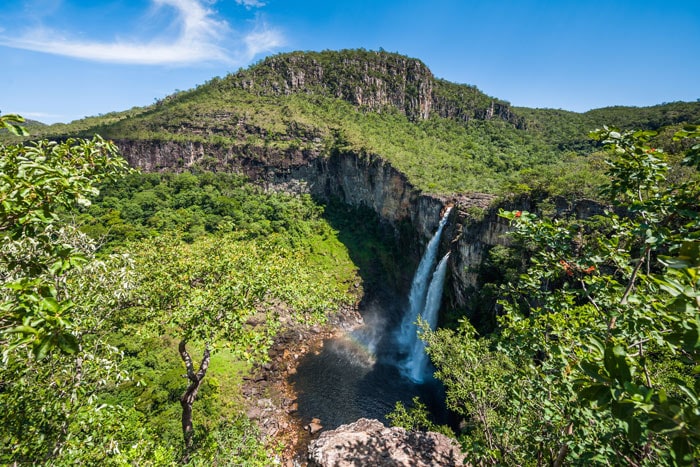
Chapada dos Veadeiros National Park
Facts about slavery in Brazil
Brazil was the country that imported the most African slaves
This disheartening fact about Brazil is still ignored by many people, while many others simply don’t know about it – the country imported by far the most slaves.
It’s estimated that about 12.5 million slaves were sent abroad, and 38.9% of all of them went to Brazil.
That’s somewhere around 4.8 million. Much more than the 2nd place British Caribbean which received about 2.3 million slaves.
Brazil was the last nation in the Americas to abolish slavery
As if having the most significant number of slaves wasn’t enough, Brazil was the last country in the Americas to abolish slavery in 1888.
After all the other countries in the western world and under significant pressure from Europe, Brazil finally abolished such horrific acts in the 19th-century.
Although this was a step toward equal rights for all races, it’s worth mentioning racism didn’t disappear from the country.

Facts about Brazil: 9% of the population is African descendant
Racism and slavery are touchy topics for the upper class in the country
Roughly 9% of the Brazilian population has African ancestry, and 46% is considered interracial, including Indigenous Brazilian, African, and European. We have ethnic groups from many regions worldwide, and we proudly say we’re a multicultural society.
See the slogan of this website, for example—experience diversity.
However, the economic inequality of blacks and mixed-race people in Brazil is alarming.
Many people claim the country is meritocratic and that racism doesn’t exist here; after all, Brazil is so multicultural, how could it be?
The reality isn’t pretty different, unfortunately. And many people, especially the upper classes of our society, simply deny talking about it.
However, more and more folks of all ethnicities feel suppressed by this. As a result, they are bringing up this and other touchy topics in the country, such as misogyny and the macho culture.
Editor’s note: The slogan of this website is “Experience Diversity” because my country is diverse, and I’m not only proud of it but I’m also fighting, together with fellow Brazilians, to make it equal for everybody.
Общая информация о Бразилии
Официальное название: Федеративная Республика Бразилия
Столица: Бразилиа
Площадь территории: 8 547,4 тыс. кв. км
Общее население: 201,1 млн. чел.
Административное деление: Государство разделено на 23 штата, один столичный округ и 3 федеральных территории.
Форма правления: Республика, с федеративным государственным устройством.
Глава государства: Президент, избираемый на 5 лет.
Состав населения: Этнические группы: белые — 53.9 %(португальцы — 20 %; итальянцы — 14 %; испанцы — 8 %; немцы — 6,6 %; арабы — 5,3 %); мулаты — 38,5 %; чёрные — 6,2 %; азиаты — 0,5 % ( японцы и пр.); индейцы — 0,43 % (тупи-гуарани, же, араваки, карибы, пано и др.).
Так же есть самбо (афро-индейцы) и пардо (коричневые) — их количество точно не известно.
Государственный язык: португальский. Также используются испанский, немецкий, итальянский, японский , украинский , английский и индейские языки.
Религия: 73,6% — католики, 15,4% — протестанты, 1,3% — спиритуалисты, 0,3% — банту/вуду, 7,4% — атеисты, 2% — другие.
Интернет-домен: .br
Напряжение в электросети: ~127 В/220 В, 60 Гц
Телефонный код страны: +55
Штрих-код страны: 789-790
Credits
New World Encyclopedia writers and editors rewrote and completed the Wikipedia article
in accordance with New World Encyclopedia standards. This article abides by terms of the Creative Commons CC-by-sa 3.0 License (CC-by-sa), which may be used and disseminated with proper attribution. Credit is due under the terms of this license that can reference both the New World Encyclopedia contributors and the selfless volunteer contributors of the Wikimedia Foundation. To cite this article click here for a list of acceptable citing formats.The history of earlier contributions by wikipedians is accessible to researchers here:
Brazil history
The history of this article since it was imported to New World Encyclopedia:
History of «Brazil»
Note: Some restrictions may apply to use of individual images which are separately licensed.
Растительный и животный мир
Растительный мир
Разнообразие климатических поясов, вместе с особенностями дренажной системы и почвы, отразились на типе бразильской растительности. В бассейне Амазонки, а также вдоль атлантического побережья с обильными осадками, раскинулся тропический лес с роскошными широколиственными деревьями, условно разделяемый на Амазонский и Атлантический.
Тропический лес богат многообразными видами растений: приблизительно 3.000 различных растений на площади 2,6 кв.км.
На равнинах и плато восточного побережья расположен полузасушливый климатический пояс с умеренными осадками и продолжительными засушливыми периодами. Здесь преобладает невысокая растительность, а в период засухи деревья сбрасывают листья.
На северо-западе страны с полузасушливым климатом преобладает caatinga, характерным элементом которой является сухой кустарник и низкорослые деревья.
Большая часть центра Бразилии покрыта сerrado — тип растительности, который представляет собой деревья и кустарники, устойчивые к засухе.
На юге находятся сосновые леса Mata Araucaria, занимающие Южное плоскогорье. Равнины, располагающиеся на уровне моря, покрыты пастбищами.
Заболоченные земли Мату Гроссу, занимающие на западе центральной части страны 230.000 кв.км, покрыты высокой травой, сорняками и деревьями. В период дождей почва оказывается затопленной.
В Бразилии представлены 55 тыс. из 250 тыс. видов растений, существующих в мире. В Бразилии насчитывается около 250 тыс. разновидностей пальм, самое большое число в мире, 2,3 тыс. видов орхидей и огромное число различных фруктов, зерновых, корнеплодов и орехов.
Животный мир
В Бразилии представлены 10% млекопитающих и земноводных, а также 17% всех птиц, существующих в мире. Помимо этого, в Бразилии обитают 55 различных видов приматов — самое большое число в мире. Из двенадцати типов млекопитающих тропического пояса, обитающих в западном полушарии, одиннадцать водятся в Бразилии, причем их количество превышает 600 видов. Сюда входят несколько разновидностей семейства кошачих, такие как пятнистый ягуар, и более мелкие — пума, сукуарана, жагуарунди и оцелот. Среди прочих млекопитающих встречаются: ленивцы, муравьеды, тапиры, броненосцы, дельфины, капивары (речные грызуны, достигающие 66 кг веса) и 30 видов обезьян.
#BANNER#
В Бразилии представлено самое большое в мире разнообразие птиц — 1600 разных видов, включая попугаев. Здесь насчитываются по крайней мере 40 видов черепах, 120 — ящериц, 230 — змей, 5 — крокодилов, 331 вид земноводных и 1500 видов пресноводных рыб. Биологами занесены в каталог около 100.000 видов беспозвоночных, включая 70000 насекомых.
Амазонские джунгли представляют собой крупнейший тропический лес мира, занимающий площадь 5,5 млн. кв. км., из которых 60% приходятся на территорию бразильских штатов Акри, Амазонас, Пара, Мато-Гроссо и Мараньяо. Остальные 40% покрывают территорию обеих Гвиан, Суринама, Венесуэлы, Колумбии, Эквадора, Перу и Боливии.
Леса Амазонки представляют собой крупнейший заповедник биологических ресурсов мира, где встречаются 30 тысяч из 100 тысяч растений, существующих в Латинской Америке. Точно неизвестно, сколько там обитает видов животных, но ученые оценивают это количество между 800000 и 5 миллионами, что составляет от 15 до 30% всех видов, населяющих планету.
Биологи занесли в каталог новые виды пресноводных рыб, в результате чего теперь насчитываются около 3000 разновидностей рыб в озерах и реках Амазонки. Среди типичных рыб региона выделяются следующие: пираруку, самая крупная пресноводная рыба в мире, отдельные экземпляры которой достигают 2 метра в длину и 125 килограммов веса; тамбаки из семейства карацидов, пожирателей фруктов, зубы которых с легкостю разгрызают косточки каучукового дерева и пальмы жауари; и, наконец, пиранья.
Свирепость этой кровожадной рыбы часто преувеличивается. Несмотря на то, что изредка пираньи убивают животных внушительных размеров и даже людей, их поведение определяется их количеством в окружающей среде. В русле больших рек и озер пираньи обычно не причиняют вреда купающимся. Они становятся агрессивными только при недостатке пищи.
Амазония — это также крупнейший гидрографический бассейн мира, общая площадь которого составляет 6 млн. кв. км. Крупнешая река этого бассейна — Амазонка, которая впадает в Атлантический океан. Средний расход воды составляет 175 млн. литров в секунду, что соответствует 20% стока всех рек планеты.
Brazilian achievements
A high-school student from Pará created a brick made of açai seeds
If you have ever had açai, chances are you probably had açai from Pará.
That’s because 90% of all açai comes from Pará, but only 4% of this Brazilian fruit is used. The rest is waste.
And so much waste was causing an environmental issue in the region.
However, the high school student Francielly Rodrigues Barbosa, 18 years old, developed bricks from açai seeds.
With her project, Francielly helped not only the environment but also the local community. That’s because she created a low-cost alternative for people whose house walls were in bad condition.
Brazilian agronomist, Johanna Dobereiner identified specific types of bacterias that helped the nutrition of non-leguminous crop plants through nitrogen fixation in the roots.
Her achievements allowed for less environmental impact and the cheaper production of soybean. Nowadays, Brazil is one of the biggest exporters of soy.

Go, girls!
A Brazilian physician discovered Chagas disease
Carlos Chagas, a physician, born in Minas Gerais, discovered in 1909 the Chagas disease, which is named after him.
The disease is more common in rural areas of Latin America.
Here are some other exciting things about Brazil and Brazilians.
- In 1903, Vital Brazil discovered the polyvalent anti-ophitic serum, which is used to treat bites from poisonous snakes.
- In 1932, José Braz Araripe developed the automatic transmission in cars using hydraulic fluid.
- In 1936, Manuel Dias Abreu invented the rapid radiography of the lungs for screening tuberculosis.
- In 1945, brigadeiro.
- In 1959, Therezinha Beatriz Alves invented the rice colander after clogging her sink multiple times.
- In 1972, Andreas Pavel invented the walkman. At the time, it was called a stereo belt.
- In 1978, Marcos dos Mares Guias discovered that genetically engineered, synthetic “human” insulin could be produced using E. coli bacteria.
- In 1996, Carlos Eduardo Lamboglia invented the electronic panel used in soccer games to indicate assisted substitutions.
- In 2000, Aron de Andrade invented an artificial heart which is connected to the natural heart and powered by an electric motor. This is the world’s cheapest artificial heart model, and the only one that doesn’t require the extraction of the organ. It weighs only 700g.
- In 2004, Eduardo Saverin co-founded .
- In 2010, Michael Krieger co-founded Instagram.
Brazilian statistics
Brazil has about 180 spoken languages
Yes, at least 180 languages. Although Portuguese is the official one, the other languages are spoken mostly by about 160,000 indigenous people.
However, according to the linguist Aryon Rodrigues from the National University of Brasilia (UnB), these languages are treated with extinction since fewer than 10,000 people currently speak them.
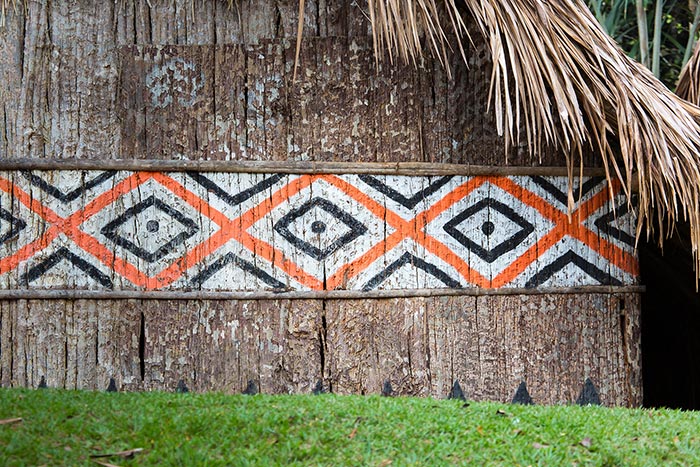
Brazil receives half the number of tourists Berlin does
While Brazil is a large country, there is still a lot to do in terms of increasing awareness about the country and attracting international tourists.
To put it into perspective, Brazil received 6.6 million tourists in 2018, while Berlin received 13.5 million in the same period.
Yes, a capital in Europe receives more tourists than a country with continental proportions.
It’s undeniable that criminality is an issue that the government isn’t very interested in solving. However, when taking necessary precautions and staying in the tourist routes, it’s improbable something will happen to visitors.
Brazil has the largest Japanese community outside of Japan
In 1908, the first Japanese immigrants arrived in Brazil, and since then, it has developed into the most significant ethnic Japanese population outside of their home country.
This is a pretty cool fact about Brazil, considering both cultures are very different from each other.
Nowadays, about 1.5 million Brazilian Japanese live in Brazil.
São Paulo has the highest GDP in the southern hemisphere
Brazil is a country of extremes, and this fact about Brazil only proves my point.
While millions of people in Brazil fight against extreme poverty, São Paulo is among the most important financial and industrial centers in the world and has the highest GDP in the southern hemisphere, let alone Latin America.
Many countries on other continents, including in Europe, have smaller economies than this huge South American city.
São Paulo dictates the pulse of the Brazilian economy as it accounts for over 30% of the country’s GDP.
The city’s GDP was about $530 billion in , while the GDP of Mexico City was about $490 billion in the same period.
Social data
Economy
Headquarters of the Central Bank of Brazil
Brasília’s economy is dominated by the services, which account for 91 percent of the local GDP. These include government, with the public sector accounting for around 40 percent of the city jobs; communications, including Brasil Telecom’s headquarters, as well as public and private television stations; banking and finance; entertainment; information technology; and legal services.
Industries in the city include construction, food processing, furniture making, recycling, pharmaceuticals, printing, and publishing.
The main agricultural products produced in Brasília are coffee, guava, orange, lemon, papaya, soy beans and mango.Brasília’s farms have over 110,000 cows and it exports wood products worldwide.
The city’s Gross Domestic Product is estimated at $27.628 billion. The participation in the Brazilian GDP is 1.8 percent. Brasília has the largest per capita income of any city in Brazil.
Infrastructure
The consumption of commercial energy at Brazil’s capital was 924 gwh, the industrial reached 337 gwh, and the residential reached 1,241 gwh. The total energy consumption was 3,319 gwh.
The railways system is not developed, with only 22.4 miles operating. However, a fast-track train connecting Brasília to Goiânia is under construction. The train will travel at an average of 115 miles per hour. Furthermore, the city has a small subway (25.5 miles) covering one «wing» of the city plan of the Distrito Federal. Railways connect the city with Rio de Janeiro and São Paulo.
Automobiles and buses are the main forms of urban transportation because of the priority afforded expressways in the city’s design and the large distances between inner-city neighborhoods. The total extension of Brasília’s paved roads is 84 miles, with 44 percent of all its roads paved. As of 2006, there were approximately 1 million vehicles in the city, for a population of about 2.3 million. Highways link Brasília with the rest of the nation.
There is regular national and international air service out of Brasília International Airport (BSB) which serves the metropolitan area. There is a television tower (735 feet high) located in the heart of the city.
Population growth
Despite its lauded planning, Brasília is far from immune from the problems of «urban sprawl.»
The 1960 census counted almost 140,000 residents in the new Federal District; by 1970 this figure had grown to more than 537,000. In 2000 the population of the Brazilian Federal District stood at more than two million, more than three times the original plan. Brasília’s inhabitants include a significant foreign population as well as large numbers of Brazilian migrants.
Brasília is considered to have one of the highest growth rates in Brazil, increasing its size by an average of 2.82 percent each year. The Human Development Index in the city is 0.844 (developed nation level), and the illiteracy rate is around 4.35 percent.
Local government
Until 1990, the Brazilian president appointed the governor of the Federal District, who was confirmed by the Senate. In that year, under the 1988 constitution, Joaquim Domingos Roriz was chosen in the first election for district governor. Reporting to the governor are numerous secretaries responsible for public works, welfare, education, law enforcement, and other concerns. The Senate acts as the legislative branch of local government. In 1986, the voters in the district elected their first congressional representatives to the national assembly, and since that time elections have been conducted the same as in any of Brazil’s states.
Climate
Brasília’s weather is semi-arid, with seasons being defined according to the degree of humidity of the air: one season is dry and colder, while the other one is humid and hot. The average temperature is 69° F. In October, the hottest month of the year, the highest temperatures stand at 85° F, while in July, which is the coldest month, the lowest temperatures stand at 55° F.
Полезная информация для туристов
Традиционные покупки — интересные и занимательные сувениры: индейские сосуды, негритянские амулеты или изделия из красного дерева пау-бразил. Лучшее место для покупки сувениров — ярмарка «Хиппи», проходящая в воскресенье. Рио имеет также крупные торговые центры — Рио Сул и Барра Шоппинг. Серьезные покупки, которые стоит делать в Бразилии, — натуральные драгоценные камни: бриллианты, изумруды, топазы.
Бразилия входит в десятку наиболее криминальных стран мира. Не рекомендуется носить дорогостоящих ювелирных украшений, крупные суммы денег, оставлять на пляже без присмотра одежду, фотоаппараты и кошельки, принимать приглашения от малознакомых людей. Не посещайте районы факел (трущоб) даже в дневное время. Никогда не оставляйте документы, деньги и ювелирные украшения в номере отеля (отели не несут ответственность за пропажу вещей из номера). В курортных предместьях Рио, в Манаусе, у водопадов Игуасу безопасно.
Чаевые в дорогих ресторанах и барах составляют 10 % от счета (если в него не входит плата за обслуживание); в дешевых закусочных — 1—2 реала; в кафе на пляже не приняты; носильщику в отеле или аэропорту дают 1 реал; таксисту округляют счет в большую сторону.
